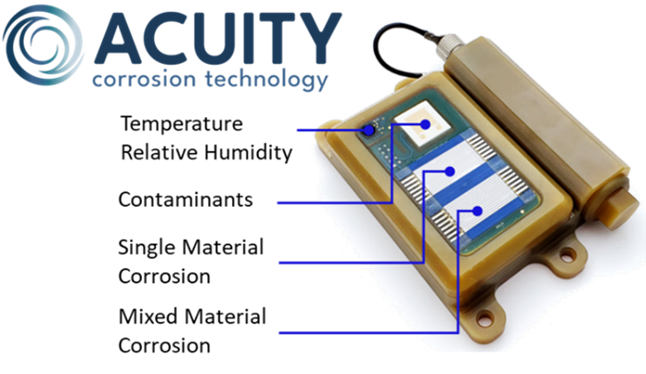
Corrosion costs the U.S. Department of Defense billions of dollars every year and is one of the leading causes of aircraft unavailability and high labor costs1.
In a paper published in Materials Performance (January 2024), Luna Labs’ team of corrosion experts describe site-to-site comparisons with real-time measurements of environment and corrosion over time to characterize environmental severity and materials performance. Using novel measurement devices and sensors to establish severity metrics is the first step in creating a framework for rapid analysis of environmental conditions that drive corrosion. Classifying locations with annual and event-driven severity metrics can improve corrosion management practices by optimizing materials selection and preventative maintenance including inspections, cleaning, and application of corrosion preventative treatments.
Tackling Corrosion in Local Environments
Environmental severity and resultant corrosivity of a local environment are influenced by a number of time dependent factors including humidity, temperature, chlorides, pH, and pollutants2. Using continuous monitoring devices with environment and corrosivity sensors, it is now possible to capture time dependent processes on the order of minutes to characterize the variation in severity due to diurnal cycles, seasonal phenomena, and weather events. These real-time monitoring devices enable rapid analysis of environment and corrosivity, and the resulting data is beginning to be used for classification of corrosion severity of geographic locations.
ESC for Aerospace Applications
The research team’s goal was to develop an approach for environmental severity classification (ESC) using real-time environment and corrosivity measurements relevant to aerospace materials and galvanic couples. A year-long outdoor exposure study was done at marine test sites in California, Washington State, and Florida using four different material combinations.
Using Acuity LS™ devices (Figure 1), environmental conditions and atmospheric corrosion were measured throughout the test period.
The real-time corrosion measurements were then mapped to an existing international standard, ISO 9223, with estimated corrosion rate ranges, to bin the test locations using six environmental severity classifications.

Figure 1. Acuity LS environment and corrosivity monitoring device
Status and Future Plans
This framework could be used for materials selection, as a site assessment tool, or for asset corrosion management to quantify corrosion severity at a given base, launch facility, test track, wind turbine, or other geographic location. This work is ongoing, and currently being applied to larger and more comprehensive datasets.
References
- E.F. Herzberg, et al., “Estimated Impact of Corrosion on Cost and Availability of DoD Weapon Systems,” FY18 Update (2018)
- ISO 9223:2019 Corrosion of metals and alloys – Corrosivity of atmospheres – Classification, determination and estimation. (2019). Third Edition.
Contact our corrosion team to discuss this and other ongoing research projects.
The researchers are grateful for the support of the US Department of the Air Force Office of Small Business and the US Department of the Navy SBIR/STTR programs under the following projects:
- HH-60W Corrosion Health Monitoring and Management: Air Force SBIR Phase II+ AF131-206 (FA8650-19-C-5090)
- Digital Twin Technologies for Airframe Corrosion: Navy SBIR Phase II N202-105 (N68335-22-C-0833)
- Test and Evaluation of Networked Environment and Corrosivity Monitoring: Air Force STTR Phase II AF21A-TCSO2 (FA2394-23-C-B020)
Additional information ISO 22858: Corrosion of metals and alloys – Electrochemical measurements – Test method for monitoring atmospheric corrosion.
For full context of this material as it was originally published, please see the following AMPP publications:
- “Environmental Severity Classification Development for Aerospace-Relevant Materials,” by Liam Agnew, Rebecca Marshall, Victoria Avance, Brandi Clark, and Fritz Friedersdorf, Materials Performance Magazine, by AMPP, January, 2024, https://www.materialsperformance.com/ .
- “Atmospheric Environment Severity Monitoring for Corrosion Management,” by Liam Agnew, Victoria Avance, Brandi Clark, and Fritz Friedersdorf, AMPP C2023-19464, 2023, https://store.ampp.org/atmospheric-environment-severity-monitoring-for-corrosion-management-548 .”

